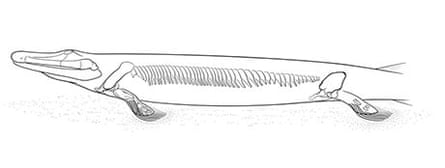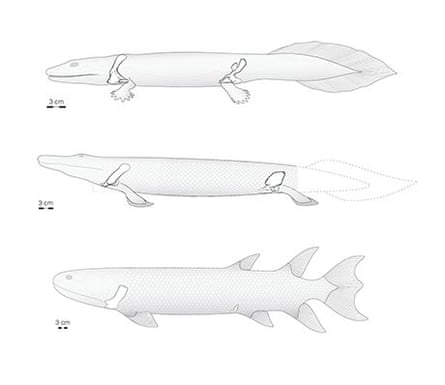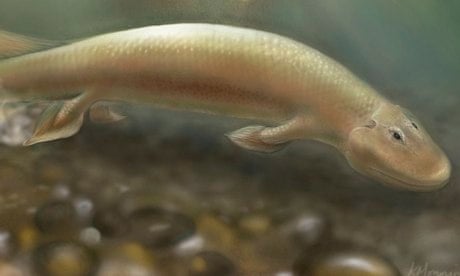The fossilised remains of an ancient beast have revealed how prehistoric life hauled itself from the water and took its first unsteady steps along the path that led to four-legged land animals.
Clues to the seminal moment in the history of life were found in the bones of Tiktaalik, a 375m-year-old freshwater creature that grew to three metres long and had aquatic features mixed with others more suited to life on land.
Scientists first discovered Tiktaalik in 2004 while hunting fossils on Ellesmere Island in the Canadian Arctic. Its extraordinary blend of gills, scales, fins and lungs, combined with a movable neck, sturdy ribcage and crocodile-like head, placed Tiktaalik half way between fish and the earliest four-legged land animals.

In work published on Monday, researchers describe fossils of the back half of Tiktaalik for the first time. The report shows that the animal had a large, robust pelvic girdle, a prominent hip joint, and long hind fins. The powerful fins could have propelled the beast in the water, but also helped it walk on riverbeds, or scramble around on mudflats.
Neil Shubin, professor of anatomy at the University of Chicago and the first author on the paper, said the most surprising find was the size of the pelvis. "To give you a sense of how giant it is, the pelvis of this animal is the same size as the shoulder, so it's very clear from understanding these bones that the hind appendage was already being emphasised in the transition to creatures with limbs," he said.
Shubin had expected the hind fins and pelvis to be small in animals like Tiktaalik, with rear limbs becoming stronger and more prominent only as animals adapted to life on land. He described the transition as moving from "front-wheel drive" in fish to "four-wheel drive" in four-legged land animals, or tetrapods. "It turns out that the size of the hind appendage was already large in fish and that a good chunk of the transition has already happened in fish before the origin of tetrapods," he said.
The latest findings are based on the fossils of five Tiktaalik specimens recovered from Ellesmere Island in Nanuvut, northern Canada. The scientists have yet to find a Tiktaalik hind fin bone, or any remains that might shed light on the origins of toes. "The hind fin of Tiktaalik is tantalisingly incomplete," Shubin told the Guardian.
Details of the fossils are reported in Proceedings of the National Academy of Sciences.

Jennifer Clack, professor and curator of vertebrate palaeontology at Cambridge University Museum of Zoology, said the Tiktaalik fossils answer a long-standing question about life's transition from water to land. "There has been a big gap in our understanding of how it happened, because the fossils did not provide any good evidence. This new material is just the sort of thing we hoped to find," she said.
"The development of a large pelvis had to happen somewhere in the transition, and given its other tetrapod-like features, it's no great surprise – but very satisfying – that the beginnings of it can be seen in Tiktaalik," she added.
Zerina Johanson, a vertebrate palaeontologist at the Natural History Museum in London, said: "Tiktaalik is one of the most important fish fossils for unravelling the evolutionary transition from fish living in water to tetrapods living on land. An important difference between fish and tetrapods, in terms of types of locomotion, is that fish tend to have larger limbs and girdles at the front of their body – the 'front-wheel' drive hypothesis – while tetrapods had substantially larger rear, or pelvic girdles.
"The transition to land was thought to be linked to these larger, more robust girdles, providing support for the hind limbs as well as the front limbs. Shubin and colleagues overturn these ideas after discovering several new robust pelvic girdles belonging to Tiktaalik, showing a condition we would associate with land in an animal that still lived in the water.
"Despite this, the girdles still show several fish-like characteristics. The Tiktaalik pelvis is a mix of fish and tetrapod characteristics, showing that the transition from water to land is not as straightforward as we previously thought, and that some tetrapod characteristics thought to be linked to the movement onto land first evolved in fishes. This also suggests that the evolution of these characteristics occurred in a series of steps, the full nature of which we still don't fully understand."

Comments (…)
Sign in or create your Guardian account to join the discussion